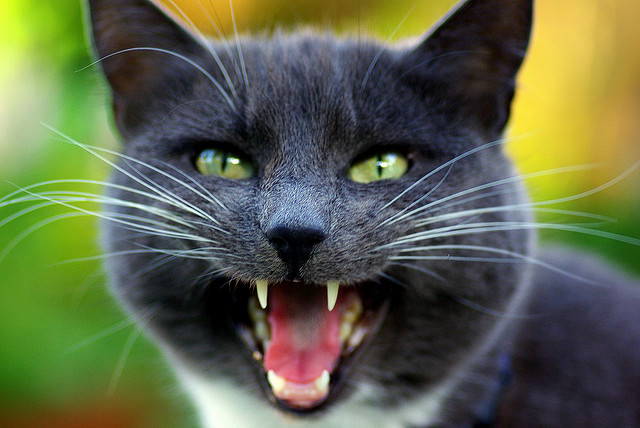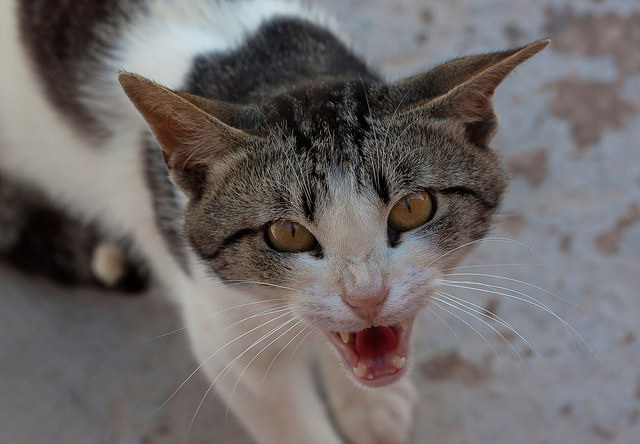We all want to understand our cats better, right? Understanding the sounds they make can help us determine their mood, intention, and needs, and ultimately make us better caretakers. Taking the time to understand vocal clues can also strengthen the human-feline bond by helping her feel like her emotions are being respected.

Image Source: David J Laporte via Flickr.com
#1 – Meow
Meows are the most quintessential cat sounds. The best part about a cat’s meow is that adult cats almost exclusively meow to communicate with humans. In fact, a cat who grows up without a human around may not know how to meow at all! In kittenhood, meows are used to communicate needs to the mama cat, but cats in the wild will usually ditch the behavior as they mature and become more independent.
A meow often announces that your cat wants something– whether that’s food, attention, or to be on the other side of a closed door. A cat’s meow can also just be a friendly greeting. Make an appointment with your veterinarian, though, if your cat starts excessively meowing, since it can indicate an underlying illness.

Image Source: jen arthur via Flickr.com
#2 – Purr
There’s something almost hypnotic about a cat’s rumbly purr. The purr usually means your cat is in a very good mood, and what could be better than being on the receiving end of a sound that indicates such bliss?
Occasionally a purr can mean your cat is very stressed out because cats sometimes purr to self-soothe. You may experience this stress purr during a trip to the veterinarian or if you incorrectly introduce a new animal to your household. It’s easy to tell the difference if you pay attention to the situation and your cat’s body language. If your cat is purring as a response to stress she’ll likely have a tense body posture and ears that lay flat against her head.

Image Source: Alisha Vargas via Flickr.com
#3 – Chatter
The chatter is my personal favorite cat sound because it is just SO SILLY sounding! You’re most likely to experience the chirp if your cat is sitting at a window, longingly staring at the birds and squirrels outside. The chatter (which sounds like her teeth are chattering) shows her excitement about the creatures and her frustration of their inaccessibility.

Image Source: Orias1978 via Flickr.com
#4 – Yowl
A yowl is a longer and more drawn-out version of your cat’s typical meow. Unlike the meow, yowls are usually meant to communicate with other cats instead of with humans. A yowling cat is often uncomfortable or worried about something– usually a territorial dispute. Cats who aren’t spayed or neutered also yowl to find mates.
Excessive yowling can indicate an underlying illness, so make an appointment with your veterinarian if there’s no clear cause.

Image Source: Tomi Tapio K via Flickr.com
#5 – Hiss
A hiss can send chills up your spine, which is exactly your cat’s intention. Cats hiss when they are feeling threatened, and scaring you can give them more control over the situation. Hisses usually come with other signs of aggressions– an arched back or flattened ears.

Image Source: HannaElise via Flickr.com
#6 – Growl
Growls are common with hisses and often turn into yowls. A growling cat is scared, angry, and feeling like her territory is being threatened. Never prod a cat who is hissing, yowling, or growling since a cat exhibiting these behaviors is ready to strike and fight. Instead, take the threat seriously and back off, giving the cat a chance to calm down.
